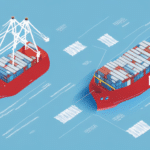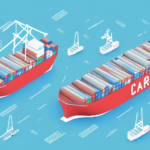Importance of Shipping Documents in International Trade
Shipping documents are fundamental to international trade, serving as the backbone of transactions between buyers and sellers. These documents ensure the smooth flow of goods across borders by providing essential information that facilitates customs clearance, payment processes, and traceability. Without accurate and complete shipping documentation, shipments can face significant delays, financial losses, and damaged business relationships.
- Evidence of Ownership and Value: Documents like commercial invoices and bills of lading establish the ownership, origin, and value of the goods being traded.
- Customs Clearance: Accurate documentation is crucial for clearing goods through customs and regulatory agencies worldwide, ensuring compliance with various laws and regulations.
- Payment Facilitation: Shipping documents enable the secure collection of payments for goods sold and services rendered.
- Tracking and Tracing: Documents create a paper trail that allows businesses to track and trace goods in transit, enhancing supply chain visibility.
- Risk Mitigation: Clear documentation outlines the terms and conditions of shipments, reducing the risk of disputes and misunderstandings between trading partners.
According to the World Trade Organization, efficient shipping documentation can significantly reduce the time and costs associated with international trade, contributing to global economic growth.
Key Types of Shipping Documents
Understanding the various shipping documents required for international trade is essential for ensuring compliance and smooth operations. The primary shipping documents include:
- Commercial Invoice: A detailed bill provided by the seller to the buyer, outlining the goods sold, their value, and terms of sale.
- Packing List: Specifies the contents of each package, including weights, dimensions, and packaging details.
- Bill of Lading: A legal document issued by the carrier that details the type, quantity, and destination of the goods being carried.
- Insurance Certificate: Provides proof of insurance coverage for the goods during transit, protecting against potential losses or damages.
- Certificate of Origin: Verifies the country where the goods were manufactured, which is often required for customs purposes.
- Customs Declarations: Documents submitted to customs authorities declaring the nature and value of the goods being imported or exported.
- Freight Forwarding Instructions: Detailed instructions provided to the freight forwarder regarding the handling and transportation of the goods.
Additional documents may be required depending on the nature of the goods and the regulations of the importing or exporting country. For instance, hazardous materials necessitate specialized documentation like Material Safety Data Sheets (MSDS).
For more detailed information on required shipping documents, refer to resources provided by the U.S. Customs and Border Protection and the World Bank.
Best Practices for Preparing Shipping Documents
Accurate and thorough preparation of shipping documents is crucial to avoid delays and ensure compliance with international regulations. Here are some best practices:
- Accurate Calculation: Carefully calculate shipping fees, taxes, and duties to prevent unexpected costs and delays.
- Completeness and Clarity: Ensure all required fields are filled out accurately and clearly to avoid misunderstandings.
- Unique Identifiers: Assign unique shipment identifiers such as tracking numbers or reference codes to facilitate easy tracking and tracing.
- Standardized Formatting: Use standardized document formats to ensure consistency and ease of processing across different platforms and regions.
- Secure Documentation Management: Keep digital or physical copies of all shipping documents in a secure and organized manner for future reference and auditing purposes.
Employing electronic document management systems (EDMS) can enhance the accuracy and efficiency of preparing shipping documents by automating data entry and reducing the risk of human error.
For comprehensive guidelines on shipping documentation, consult the Export.gov Shipping and Customs resources.
Common Mistakes to Avoid in Shipping Documentation
Errors in shipping documentation can lead to significant disruptions in the supply chain. Common mistakes include:
- Inaccurate Information: Providing incorrect details about the goods, such as quantity, description, or value, can lead to customs clearance issues.
- Incomplete Documentation: Missing required documents can result in shipment delays or rejections at customs.
- Incorrect Calculation: Miscalculating shipping fees, taxes, or duties can cause financial discrepancies and delays in payment processing.
- Lack of Standardization: Using inconsistent formats or templates can confuse stakeholders and hinder automated processing.
- Failure to Assign Unique Identifiers: Not providing unique tracking numbers can make it difficult to monitor the shipment's progress.
To mitigate these risks, businesses should implement thorough checks and utilize automated systems to ensure the accuracy and completeness of all shipping documents.
Additional insights on avoiding documentation errors can be found in the International Trade Centre resources.
Consequences of Inaccurate Shipping Documents
Inaccurate or incomplete shipping documents can have severe repercussions for businesses engaged in international trade:
- Customs Delays: Incorrect documentation can lead to prolonged customs clearance times, delaying the delivery of goods.
- Financial Penalties: Non-compliance with documentation requirements can result in fines, penalties, or even confiscation of goods.
- Damage to Business Relationships: Delays and errors can erode trust between trading partners, harming long-term business relationships.
- Increased Operational Costs: Handling documentation errors often requires additional resources, such as expedited shipping or legal assistance, increasing overall costs.
Furthermore, inaccurate documentation can lead to legal disputes and damage a company's reputation in the international market.
To understand the financial impact of documentation errors, refer to reports by the Organisation for Economic Co-operation and Development (OECD).
Streamlining the Shipping Documentation Process
Efficient management of shipping documentation is essential for minimizing errors and improving overall supply chain performance. Here are some strategies to streamline the process:
- Automation and Shipping Software: Utilize advanced shipping software and automation tools to reduce manual entry errors and speed up the documentation process.
- Staff Training: Ensure that employees involved in preparing shipping documents are well-trained and knowledgeable about current regulations and best practices.
- Standardized Templates: Develop and use standardized templates for all shipping documents to maintain consistency and reduce preparation time.
- Centralized Document Management: Implement a centralized repository for storing and managing shipping documents, ensuring easy access and retrieval.
Adopting a digital transformation approach can significantly enhance the efficiency and accuracy of shipping documentation. Leveraging technologies such as blockchain for secure and transparent document handling further optimizes the process.
For more information on streamlining shipping processes, visit the ScienceDirect publications.
Future Trends in Shipping Documentation
The landscape of shipping documentation is rapidly evolving, driven by technological advancements and changing regulatory environments. Key trends and innovations to watch include:
- Paperless Documentation: The shift towards digital documents reduces reliance on physical paperwork, lowering costs and enhancing efficiency.
- Blockchain Technology: Blockchain offers secure and immutable record-keeping, improving transparency and trust in shipping documentation.
- Artificial Intelligence (AI) and Machine Learning: AI-powered tools can automate data entry, identify discrepancies, and predict potential compliance issues.
- Electronic Data Interchange (EDI): EDI systems facilitate the seamless exchange of documents between trading partners, enhancing communication and reducing delays.
- Advanced Data Analytics: Leveraging data analytics enables businesses to gain insights into their shipping processes, identify inefficiencies, and optimize performance.
Staying abreast of these trends will allow businesses to adopt innovative solutions that enhance the accuracy, security, and efficiency of their shipping documentation processes.
Explore the latest research on shipping documentation trends through the Massachusetts Institute of Technology (MIT).
Conclusion
Shipping documents are indispensable in facilitating international trade, ensuring that goods move smoothly across borders while complying with various regulations. Proper preparation and management of these documents not only prevent delays and financial losses but also strengthen business relationships and enhance customer satisfaction. By implementing best practices, avoiding common mistakes, and embracing technological advancements, businesses can optimize their shipping documentation processes, leading to more efficient and profitable operations.
For further reading and resources on international shipping documentation, visit the Export.gov website.




















